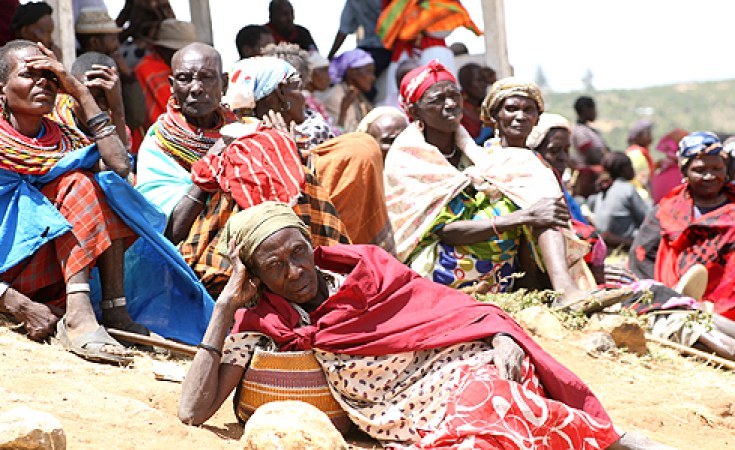It is noon in Nkaroni village, in Samburu East, and the sun is blazing down over the vast land with searing heat.
The temperature has crossed 30 degrees Celsius mark and rising. Hungry children are clinging onto their parents' shukas (traditional wear), with their lives pegged on hope.
The drought that has ravaged this village in Samburu County and several parts of northern Kenya since January last year has been devastating, leaving families in a desperate situation.
More than 10 counties in Kenya's north are affected by the prolonged drought, and, according to the government, at least 2 million people are in need of clean water and food.
Worsening by the day
The drought in Samburu, Marsabit, Turkana, Isiolo and parts of Baringo, is worsening by the day, with desperate families trekking long distances in search of food, water and pasture for their livestock.
Women, children and the elderly are the most affected, as the dry spell persists. Their livestock, the main source of livelihood, has been decimated.
Scorched fields here tell the story of one of the worst droughts the northern region has faced yet, and residents here appear to have been left to their own devices.
In Samburu, South Horr, Barseloi, Wamba, Suyan, Loonjorin, Ntepes, Archer's Post and Nachola are the worst-hit areas. A spot check by the Nation in the affected areas established a desperate situation.
In some areas, desperate families have been waking up as early as 4am to sit on roadsides to beg for food and water from travellers.
Scorching sun
Throughout the day, they endure the scorching sun, and with herders, they chase after vehicles hoping to secure something to quench their thirst and fill their hungry tummies.
Elizabeth Naserian is one of the desperate residents of Loonjorin, who has gone for days without food after the little donation she had received ran out.
"We are hoping God will save our lives because the situation is bad. We do not have food and water. The drought has lasted several months and if the government does not come to our aid, we will die," said Naserian, a mother of five.
Pastoralist communities from neighbouring Marsabit, Isiolo, Baringo and Turkana counties have been forced to travel several kilometres in search of water and pasture for their livestock.
According to the National Drought Management Authority (NDMA), in Samburu alone, at least 100,000 pastoralists are at risk of starvation
Though no deaths have been reported so far, if the situation remains unchecked it will degenerate into a disaster, residents told the Nation.
The drought has been triggered by absence of rains for the last couple of months and the water table in the affected regions has gone down drastically.
Likely to get worse
Samburu NDMA County Coordinator Alex Leseketet says the situation is likely to get worse.
Samburu East region is the worst hit, with water, pasture and food stocks having run out several months ago.
"Samburu County is on an alert stage but the trend is really worsening very fast. In Samburu East, most wells and dams dried and people are suffering. That is why we placed the area on an alarming state list," Mr Leseketet said.
Emaciated livestock
Livestock prices have also dropped sharply after they became emaciated due to lack of water and pasture.
Samburu County Special Programmes Chief Officer Daniel Lesaigor said more than 100,000 people are in dire need of relief food and water.
He appealed for help as the available food (253 metric tonnes) can only serve a population of 36,000.
Most school-going children, he said, have dropped out amid mass migrations in search of water.
"We had mapped out about a population of 36,000 across the entire Samburu County in March. But as the droughts continue, we have realized more than 100,000 urgently need help," Lesaigor said.
There is also concern that the situation may spark conflicts as groups scramble for the already scarce resources.
Conflict among pastoralists
The drought is exacerbating conflict among pastoralists, with fights breaking out at water points. Several people have already died in clashes over water at Komu area on Samburu-Isiolo border over the last one month.
"The conflicts often surround access to water and pasture points. The conflicts have increased with the drought," said Samburu County Commissioner Abdirazak Jaldesa.
There is a reported shortage of animal feed in Samburu and Isiolo counties, with some livestock farmers appealing to the government to intervene.
Local leaders have appealed to the government and non-governmental organisations to support drought-stricken residents.
Led by governors Moses Lenolkulal (Samburu) and Stanley Kiptis (Baringo), they said they need urgent help to save people and animals.
"I call upon the Ministry of Devolution and other development partners to urgently help us with relief food for families affected by the drought," Mr Lenolkulal said.
Samburu East MP Jackson Lentoijoni called for urgent interventions to stop further ethnic clashes over control of water points and grazing fields.
"This is a critical moment and as leaders we appeal for a relief food to cushion starving locals. We are also in talks with herders find a solution on escalating attacks over access of water points," the MP said.
ematara@ke.nationmedia.com, gondieki@ke.nationmedia.com








